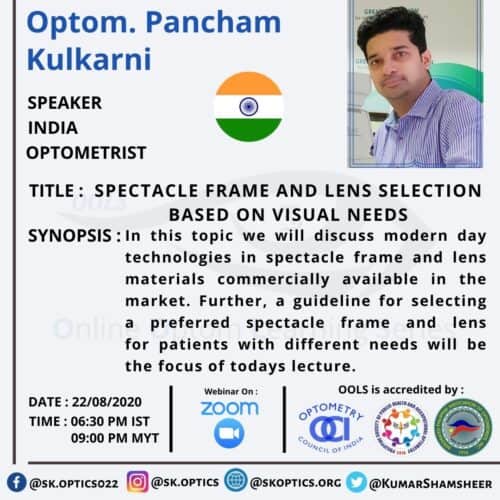
Mr. Pancham Kulkarni, a practicing optometrist and academician, begins with the three key aspects for a satisfied customer. They are accurate refraction, appropriate frame selection, and lens fitting. This talk focuses on frame selection and lens measurements.
We start by choosing the right frame material for each customer. We learn in detail about the features of the following frame materials.
- Plastic molded frames
- TR – 90 nylon and ultem frames
- Mira flex frames
- Cellulose acetate frames
- Optyl frames
- Metal frames
After learning about the different frame materials we learn about selecting the appropriate lens for the customer. The following is a list of lenses that we discuss in detail
- High index lenses
- Aspheric lenses
- Polycarbonate lenses
- Trivex Lenses
- Photochromatic lenses
- Transition Classic
- Transition Signature 7
- Transition XTRActive
- Transition Drive
Following the lens materials, Mr. Kulkarni mentions the importance of anti-reflection coating (ARC) and the multi-layer ARC. We then talk in detail about the blue filter and blue cut lenses.
The sources of blue light and the different types of lenses available in the market, along with their advantages and disadvantages. We also discuss the anti-fogging lenses
The next part of the session discusses presbyopia correction, starting with ‘No-line bifocals’. Mr. Kulkarni then discusses the progressive addition lenses and the critical aspect to keep in mind for the right lens selection. We also learn about the customized design options available.
Lastly, we focus on myopia control lenses. There are not available in India as of September 2020. However, we review some of the studies and their outcomes using these myopia control lenses. We then conclude the session with a Q and A session with our live audience.
References
Websites
Blue Light
https://www.aao.org/eye-health/tips-prevention/should-you-be-worried-about-blue-light
Myopia control lenses
https://www.myopiaprofile.com/myopia-control-spectacles-part-3-new-designs-latest-studies
Papers
Blue Light
Zhao ZC, Zhou Y, Tan G, Li J. Research progress about the effect and prevention of blue light on eyes. Int J Ophthalmol. 2018;11(12):1999-2003. Published 2018 Dec 18.
https://pubmed.ncbi.nlm.nih.gov/30588436/
Myopia Control
Edwards MH, Li RW, Lam CS, Lew JK, Yu BS. The Hong Kong progressive lens myopia control study: study design and main findings. Invest Ophthalmol Vis Sci. 2002;43(9):2852-2858.
https://pubmed.ncbi.nlm.nih.gov/12202502/
Gwiazda J, Hyman L, Hussein M, et al. A randomized clinical trial of progressive addition lenses versus single vision lenses on the progression of myopia in children. Invest Ophthalmol Vis Sci. 2003;44(4):1492-1500.
https://pubmed.ncbi.nlm.nih.gov/12657584/
Cheng D, Woo GC, Drobe B, Schmid KL. Effect of bifocal and prismatic bifocal spectacles on myopia progression in children: three-year results of a randomized clinical trial. JAMA Ophthalmol. 2014;132(3):258-264.
https://pubmed.ncbi.nlm.nih.gov/24435660/
Sankaridurg P, Donovan L, Varnas S, et al. Spectacle lenses designed to reduce progression of myopia: 12-month results [published correction appears in Optom Vis Sci. 2010 Oct;87(10):802]. Optom Vis Sci. 2010;87(9):631-641.
https://pubmed.ncbi.nlm.nih.gov/20622703/
Lam CSY, Tang WC, Tse DY, et al. Defocus Incorporated Multiple Segments (DIMS) spectacle lenses slow myopia progression: a 2-year randomised clinical trial. Br J Ophthalmol. 2020;104(3):363-368.
